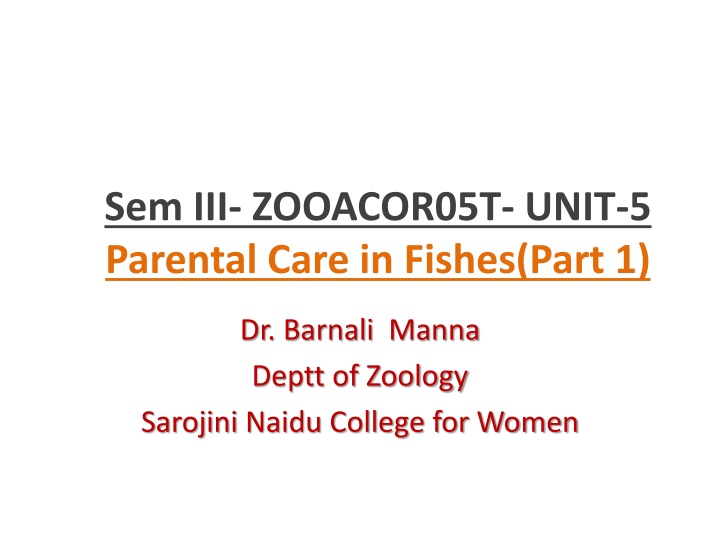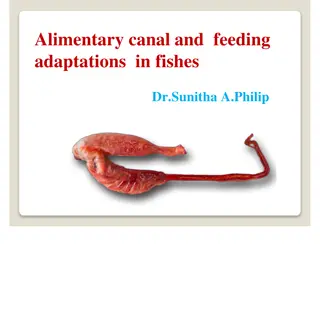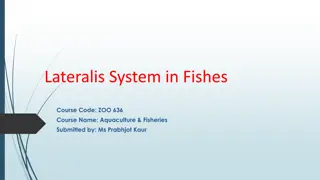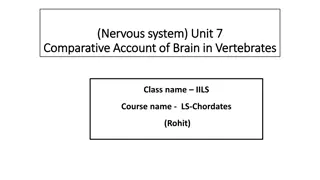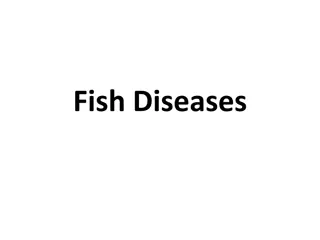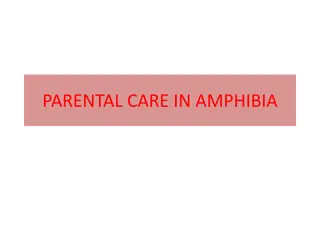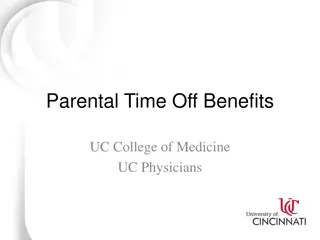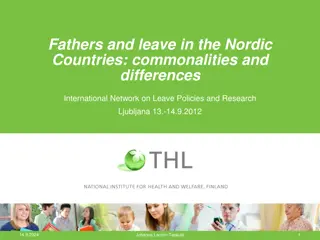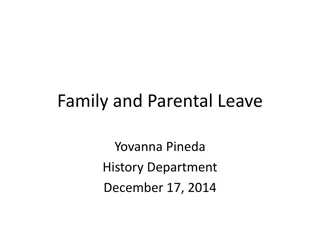Parental Care in Fishes: Importance and Diversity
Parental care in fishes is an instinctive behavior that ensures offspring survival and reproductive success. It can be provided by males, females, or both parents, with different types of care strategies such as maternal care, biparental care, and various methods of protecting eggs and young. The costs and benefits of parental care are discussed, highlighting its role in the perpetuation of fish species.
Download Presentation

Please find below an Image/Link to download the presentation.
The content on the website is provided AS IS for your information and personal use only. It may not be sold, licensed, or shared on other websites without obtaining consent from the author.If you encounter any issues during the download, it is possible that the publisher has removed the file from their server.
You are allowed to download the files provided on this website for personal or commercial use, subject to the condition that they are used lawfully. All files are the property of their respective owners.
The content on the website is provided AS IS for your information and personal use only. It may not be sold, licensed, or shared on other websites without obtaining consent from the author.
E N D
Presentation Transcript
Sem III- ZOOACOR05T- UNIT-5 Parental Care in Fishes(Part 1) Dr. Barnali Manna Deptt of Zoology Sarojini Naidu College for Women
What is parental care?? Parental care is an inborn instinctive behaviour shown by different species of fish. Parental care is evolved in those organism which produce limited number of eggs to ensure the continuity of their race.
Why parental care? Increase offspring survival Improve offspring growth rate and quality Directly increase offspring reproductive fitness. Perpetuation of race.
Maternal care: provided by the mother alone. viviparity is a remarkable example of maternal care.
In contrast to other animals,in fish,it is the males that usually provide care. Biparental care: care is provided by both parents together or in sequences. Ratio of fish genera that exhibit male only:biparental: female only care = 9:3:1
Cost & Benefits of Parental care 3 main costs : Decreased parental survival Increased time until the next breeding attempt Reduced future fecundity Benefits It improves survival and development of young ones.
Diversity and types of parental care A. Deposition of eggs in suitable places. B. Deposition of eggs into self-made nest. C. Hiding or concealing eggs & young ones in or into their body . D. Viviparity. E. Care of independently swimming young s.
Deposition of eggs in suitable places 1.Deposition of eggs in sticky covering 2.eggs scattered over aquatic plant 3.eggs layed in pits 4.eggs layed on dead shells of bivalves
Deposition of Eggs in Sticky covering In carps(common carp) eggs are usually laid with some special sticky covering by which they are attached with each other or to stones ,weeds etc. In yellow perch(Perca flavescens) eggs are deposited in a rope like structure.The eggs are held together by a long floating membrane.
Eggs scattered over Aquatic Plants Eggs of fishes such as pikes (Esox lucius), carps (Cyprinus carpio), Carrassius auratus etc., are scattered over aquatic plants to which they remain attached.
Eggs layed in pits: Anadromous fishes (lives in the sea but migrates to fresh water for breeding) such as Salmo solar, Acipenser, Oncorhyncus etc., lay their eggs in suitable spawning grounds. They dig excavation in gravel substrate, lay their eggs in the pits, cover them with gravel and desert them. Sand Gobi (Pomatoschistos minutus) lay their eggs in some protected place,guarded by male who also aerate them.
Eggs scattered on dead shells of bivalves Females(cyprinid family) deposit their eggs on the dead shells of mussels Females of european bitterling (Rhodeus amarus) deposit eggs in the siphon of a mussel by means of a long tube drawn out from the oviduct.After oviposition male fish immediately sheds the sperms over the eggs and guards them.
OVIPARY, OVOVIVIPARY, VIVIPARY these terms used to describe what happens when future offspring separates from parent OVIPARY eggs are released and develop outside body of female, fertilisation internal or external, egg yolk only nutrition.Eg.almost all fishes. OVOVIVIPARY Internal fertilisation, egg shell soft, eggs hatch inside body, appears to be born alive, egg yolk nutrition,without placental attachment, mother for protection.Eg Sharks,Skates,Ray etc. VIVIPARY fertilisation internal, no egg shell, nutrition via placenta. Eg. Poecilia reticulata
OVOVIVIPARY how is reproduction maximised? Fewer eggs needed higher survival rate of offspring. Developing embryo much less vulnerable to predators. Developing embryo not subject to environmental changes e.g. temperature. Young born fully developed, can feed and escape predators more easily. Occurs in some invertebrates, fish and reptiles.
VIVIPARY maximising reproduction Occurs in placental mammals, some sharks (Scoliodon) Fertilisation internal, no shell. Placenta responsible for nutrition young born alive 1. fewer eggs necessary 2. energy available for nourishment and protection of embryo, as well as parental care
